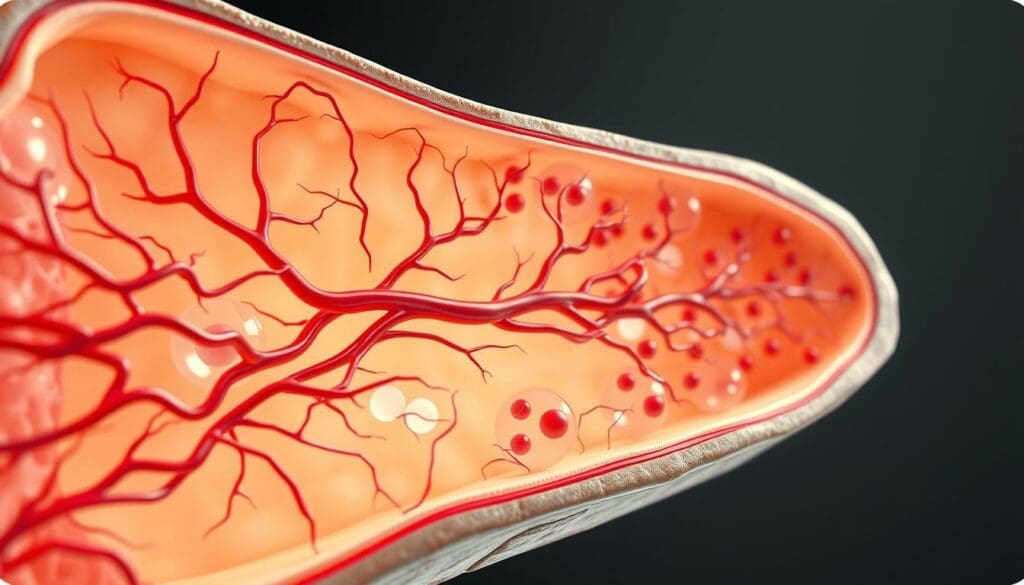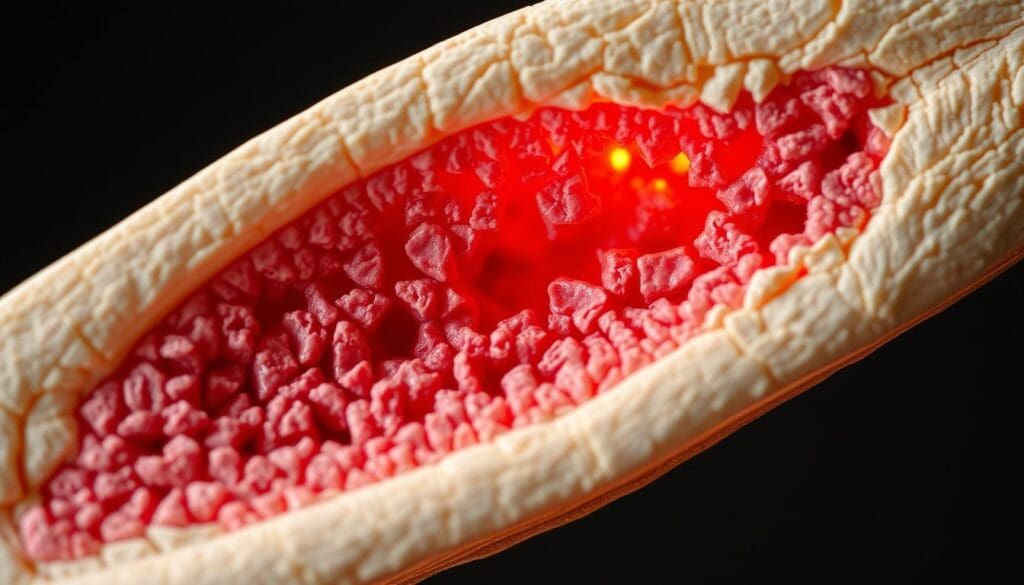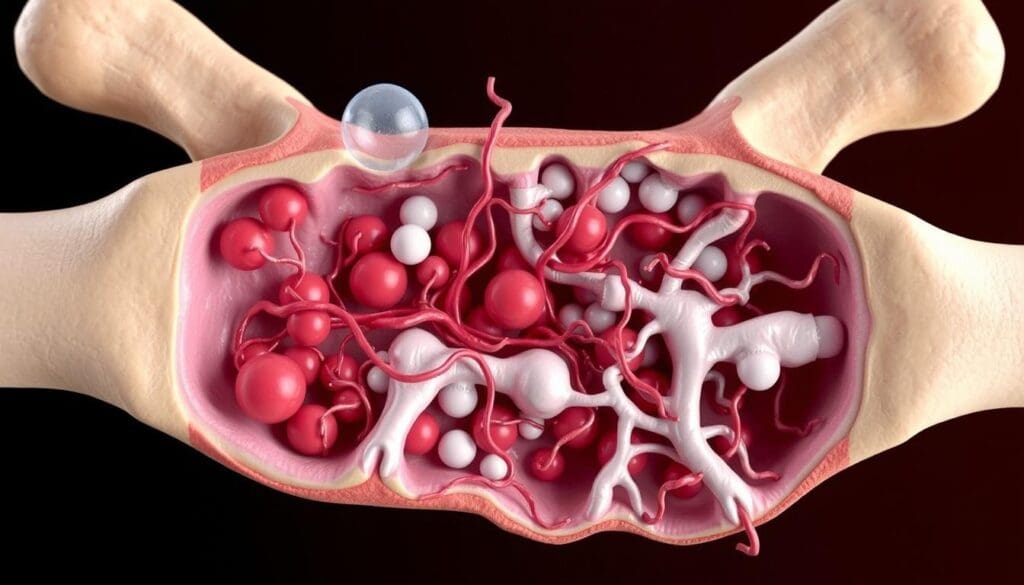Last Updated on November 17, 2025 by Ugurkan Demir

When the body’s red blood cell production is disrupted, it can lead to health issues. At LivHospital, we focus on the root causes of anemia, mainly bone marrow disorders.
Bone marrow is the spongy tissue inside some bones. It’s key for making red blood cells, white blood cells, and platelets. Problems like aplastic anemia and myelodysplastic syndrome can stop this production, causing anemia.
We know diagnosing and treating anemia caused by bone marrow issues is tough. Our team is dedicated to giving full care and advice to those dealing with these complex health problems.

Bone marrow is a spongy tissue inside our bones, like the hips and thighbones. It’s key for making blood cells. This is important for our health.
Bone marrow has stem cells that turn into different blood cells. This includes red blood cells, white blood cells, and platelets. It’s vital for keeping our blood healthy and our body’s tissues oxygenated.
Our body needs bone marrow to make red blood cells. These cells carry oxygen everywhere in our body. Making red blood cells is a complex process that depends on our nutrition and health.
The making of red blood cells goes through several stages. It starts with stem cells turning into erythroblasts. Then, they become reticulocytes and eventually red blood cells. This process is controlled by growth factors and hormones.
Here’s a simplified overview of the red blood cell production process:
| Stage | Description |
| Stem Cell Differentiation | Stem cells differentiate into erythroblasts |
| Erythroblast Maturation | Erythroblasts mature into reticulocytes |
| Reticulocyte Release | Reticulocytes are released into the bloodstream |
| Maturation to Red Blood Cells | Reticulocytes mature into red blood cells |
Understanding bone marrow and red blood cell production is key. It helps us see how bone marrow diseases affect our health. Knowing how these processes work helps us understand the challenges of bone marrow disease anemia.

Bone marrow disease anemia refers to several disorders that affect red blood cell production. It happens when the bone marrow can’t make enough red blood cells, causing anemia.
This condition can be caused by different things, like aplastic anemia and myelodysplastic syndrome. These affect how blood cells are made. Knowing the cause is key to treating it right.
Bone marrow failure means the marrow can’t make blood cells fast enough. This can happen for many reasons, such as:
The reasons for bone marrow failure are complex. They involve genetics and the environment. Understanding these mechanisms is vital for finding good treatments.
Bone marrow disorders can really mess with blood cell production. This can lead to anemia, neutropenia, and thrombocytopenia. It affects the making of red blood cells, white blood cells, and platelets.
The effects of not making enough blood cells can be serious. They include:
It’s important to catch bone marrow disorders early. This helps avoid serious problems and improves how patients do.
Non-cancerous bone marrow disorders can affect how blood cells are made. This can lead to anemia. These disorders can make it hard for the bone marrow to create healthy red and white blood cells, and platelets. We will look at aplastic anemia and myelodysplastic syndrome, and how they impact blood cell production.
Aplastic anemia is when the bone marrow can’t make blood cells. This results in fewer red and white blood cells, and platelets. Causes include toxins, some medicines, and viruses. Early diagnosis is key for treatment.
Myelodysplastic syndrome (MDS) means the bone marrow makes bad blood cells. It can turn into acute myeloid leukemia. Symptoms include tiredness, weakness, and shortness of breath. Knowing how MDS progresses is important for managing it.
Other syndromes like Fanconi anemia and Diamond-Blackfan anemia also cause anemia and blood disorders. It’s important to know about these to give the right care and treatment.
| Condition | Description | Key Symptoms |
| Aplastic Anemia | Failure of bone marrow to produce blood cells | Fatigue, weakness, infections |
| Myelodysplastic Syndrome (MDS) | Production of abnormal blood cells | Anemia, fatigue, shortness of breath |
| Fanconi Anemia | Inherited condition leading to bone marrow failure | Congenital abnormalities, anemia |
Knowing about non-cancerous bone marrow disorders is key for diagnosis and treatment. Recognizing symptoms helps healthcare providers give better care. This improves patient outcomes.
It’s important to know the difference between inherited and acquired bone marrow disorders. These conditions affect how blood cells are made, leading to health problems. Knowing the type of disorder helps doctors choose the right treatment.
Fanconi anemia is a rare genetic disorder that causes bone marrow failure. This leads to fewer blood cells being made. It’s usually found in children and can cause aplastic anemia, leukemia, and other issues. Other inherited disorders include Diamond Blackfan anemia and Shwachman-Diamond syndrome.
Inherited bone marrow disorders are unique because they come from genetics. They can be linked to other birth defects. Treatment often includes blood transfusions and sometimes stem cell transplants.
Diamond Blackfan anemia affects the production of red blood cells. It’s often found in babies or young children, but can be diagnosed later. The bone marrow fails to make enough red blood cells, causing anemia.
Treatment for Diamond Blackfan anemia includes corticosteroids and blood transfusions. Knowing the details of these conditions is key to giving the best care. Some patients may need more aggressive treatments like stem cell transplants. Understanding the difference between inherited and acquired disorders helps doctors make better choices for their patients.
Red blood cells are key for our health. If the body can’t make them, it’s a big problem. We’ll look at why this happens and how it affects our body’s ability to get oxygen.
There are several reasons why the body might not make enough red blood cells. Bone marrow disorders like aplastic anemia and myelodysplastic syndrome can cause this. These issues stop the bone marrow from making healthy red blood cells, lowering the count.
The reasons for this problem include:
Not having enough red blood cells means less oxygen gets to our tissues and organs. This can cause tiredness, weakness, and trouble breathing.
The effects of not making enough red blood cells are serious. They include:
In summary, not making enough red blood cells is a big health issue. Knowing why this happens and how it affects our body is key to finding good treatments.
Bone marrow disease anemia shows up in many ways, affecting a person’s life a lot. Spotting these signs early is key to better care and treatment.
Fatigue and weakness are common signs. They happen because the body makes too few red blood cells. This means less oxygen gets to the body’s parts.
This makes people feel very tired. It can make it hard to do everyday things.
“The fatigue from anemia is really tough,” says a hematology expert. “It affects both body and mind. It’s important for patients to tell their doctors about these symptoms.”
Anemia can also make you more likely to get sick. When the bone marrow doesn’t make enough white blood cells, fighting off infections is harder. This can lead to getting sick often, taking longer to get better, and serious health problems.
Bleeding easily is another sign. This happens when there are not enough platelets. It can cause easy bruising, nosebleeds, or bleeding that doesn’t stop after injuries or surgeries.
People might also have pale skin, shortness of breath, and dizziness. This is because the blood can’t carry enough oxygen.
Seeing these signs early is very important. It helps doctors start the right treatment fast. This can make a big difference in how well a patient does.
It’s important to tell apart aplastic anemia and myelodysplastic syndrome for the right treatment. Both affect the bone marrow’s blood cell production. Yet, they stem from different causes and have different outcomes.
Aplastic anemia happens when the bone marrow can’t make blood cells. This is because the stem cells that make blood are destroyed or don’t work right. Myelodysplastic syndrome, on the other hand, is when the bone marrow makes blood cells but they don’t work well. This is because the cells are not made right or die too early.
Aplastic anemia can start on its own or be caused by toxins, drugs, or viruses. Myelodysplastic syndrome can also start on its own or be caused by chemotherapy, radiation, or genetic disorders.
Genetics are key in both conditions. Aplastic anemia can be linked to genetic changes in stem cells. Myelodysplastic syndrome is often linked to specific genetic changes like deletions or translocations. These changes can affect how the disease progresses.
Knowing these genetic differences is vital for diagnosis and treatment. For example, some genetic changes in myelodysplastic syndrome can mean a higher risk of turning into acute myeloid leukemia.
The outlook for aplastic anemia and myelodysplastic syndrome patients varies. It depends on the cause, age, and how well they respond to treatment. Aplastic anemia can sometimes be cured with treatment or a bone marrow transplant.
Myelodysplastic syndrome’s outlook is more varied. Some patients stay stable for years, while others may turn into acute myeloid leukemia. The International Prognostic Scoring System (IPSS) helps predict how well a patient with myelodysplastic syndrome will do.
In summary, knowing the differences between aplastic anemia and myelodysplastic syndrome is key. Understanding their causes, genetic factors, and how they progress is essential. Accurate diagnosis leads to the right treatment and better outcomes for patients.
Understanding how to diagnose bone marrow disorders is key for doctors. They use a mix of clinical checks, lab tests, and special procedures to get the right diagnosis. This helps them manage these conditions well.
Blood tests are the first step in finding out about bone marrow disorders. A Complete Blood Count (CBC) is a key test. It looks at the levels of different blood cells.
For example, a low red blood cell count means there’s a problem with making red blood cells in the bone marrow. A low white blood cell count or platelet count also points to bone marrow issues.
| Blood Test | Normal Range | Indications of Abnormality |
| Red Blood Cell Count | 4.32-5.72 million cells/μL | Anemia, Bone Marrow Failure |
| White Blood Cell Count | 3.5-12.5 thousand cells/μL | Leukopenia, Infection Risk |
| Platelet Count | 150-450 thousand cells/μL | Thrombocytopenia, Bleeding Risk |
A bone marrow biopsy and aspiration are key to diagnosing bone marrow disorders. They involve taking a sample of bone marrow for study.
The biopsy shows the marrow’s structure and cell count. The aspiration looks at the cells. Together, they help find diseases like aplastic anemia and myelodysplastic syndromes.
Genetic testing is important for diagnosing some bone marrow disorders. This is true for conditions like Fanconi anemia. Tests like next-generation sequencing (NGS) and fluorescence in situ hybridization (FISH) find genetic problems.
These tests help doctors create treatment plans that fit each patient’s needs.
Managing bone marrow disease anemia needs a detailed plan. This plan includes different treatments. The right treatment depends on the cause, how severe it is, and the patient’s health.
Blood transfusions are a key treatment for severe anemia. They increase red blood cells, easing symptoms like tiredness and weakness.
Supportive care is also important. It helps manage symptoms and prevent problems. This might include iron chelation therapy to handle iron buildup from transfusions.
Immunosuppressive therapy is used for aplastic anemia. It uses medicines to calm the immune system. This helps the bone marrow work better.
Medicines like cyclosporine and anti-thymocyte globulin (ATG) are used. They aim to help the bone marrow recover and make blood cells more effectively.
Stem cell transplantation is a possible cure for some bone marrow disorders. It replaces damaged bone marrow with healthy stem cells from a donor.
This method is complex and risky. But, it can be very effective for severe cases of bone marrow disease anemia.
New treatments for bone marrow disease anemia are being researched. These include gene therapy, new immunosuppressive agents, and other innovative methods.
Clinical trials are key to testing these new treatments. They check if these treatments are safe and work well. Patients should talk to their doctors about joining clinical trials.
| Treatment Option | Description | Indications |
| Blood Transfusions | Regular transfusions to increase red blood cell count | Severe anemia, low red blood cell count |
| Immunosuppressive Therapy | Medications to suppress the immune system | Aplastic anemia, immune-mediated bone marrow suppression |
| Stem Cell Transplantation | Replacing damaged bone marrow with healthy stem cells | Severe bone marrow failure, certain genetic disorders |
In conclusion, there are many treatment options for bone marrow disease anemia. The right one depends on the cause and how severe it is. We keep learning and improving how to treat this condition, giving hope to patients.
For those with bone marrow disorders, getting care at specialized centers can really help. These places have teams of experts ready to tackle complex conditions like bone marrow disease anemia. They offer a full range of care.
Specialized care centers use the newest technology and treatments. They have advanced diagnostic protocols for accurate diagnoses and custom treatment plans. Expert says these diagnostics are key for managing aplastic anemia and other bone marrow issues.
These centers also have many treatment options. This includes immunosuppressive therapy and stem cell transplantation. The right treatment depends on the diagnosis, how severe the disease is, and the patient’s health.
LivHospital is a top choice for bone marrow disease anemia care. It has a team of skilled hematologists, oncologists, and other specialists. They work together to create treatment plans that fit each patient.
At LivHospital, patients get access to the latest treatments and clinical trials. This ensures they get the best care possible. The hospital’s focus on a team approach and patient care makes it a great option for complex bone marrow disorders.
Bone marrow disease anemia is a complex condition. It needs a deep understanding of its causes, symptoms, diagnosis, and treatment. This article has covered the main points about bone marrow disease anemia.
We’ve learned that bone marrow disorders can be inherited or acquired. Conditions like aplastic anemia and myelodysplastic syndrome can harm red blood cell production. Knowing this is key to managing the condition well.
The management of bone marrow disease anemia is complex. It includes blood transfusions, immunosuppressive therapy, and stem cell transplantation. Specialized care centers like LivHospital offer advanced diagnostic and treatment options.
In summary, understanding bone marrow disease anemia is important. Effective management and treatment can greatly improve life quality for those affected.
Bone marrow disease anemia happens when the bone marrow can’t make enough red blood cells. This leads to anemia. It’s caused by disorders like aplastic anemia and myelodysplastic disease anemia.
Bone marrow makes blood cells, including red blood cells. It uses stem cells in a process. Knowing this helps us understand how diseases affect red blood cell production.
Symptoms include feeling tired, weak, and getting sick more easily. Spotting these signs early is key for treatment.
Aplastic anemia means the bone marrow can’t make blood cells. Myelodysplastic syndrome means it makes bad blood cells. Knowing the difference is important for the right treatment.
Doctors use blood tests, bone marrow biopsies, and genetic tests to diagnose. These tools help manage bone marrow diseases well.
Treatments include blood transfusions, drugs to suppress the immune system, stem cell transplants, and new treatments. The right treatment depends on the cause and how severe it is.
Inherited disorders, like Fanconi anemia, come from genetic mutations. Acquired disorders, like aplastic anemia, come from outside factors. Knowing this affects treatment choices.
Yes, places like LivHospital have advanced care. They offer detailed diagnosis and treatment for complex bone marrow disorders.
Not enough red blood cells means less oxygen for tissues and organs. This can cause fatigue and weakness.
Yes, new treatments and clinical trials are being explored. They aim to improve care for bone marrow disease anemia patients.
References
Subscribe to our e-newsletter to stay informed about the latest innovations in the world of health and exclusive offers!